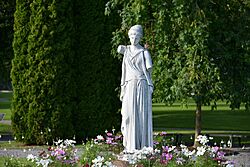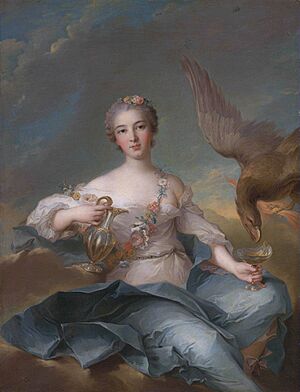Hebe facts for kids
Quick facts for kids Hebe |
|
|---|---|
|
|

Statue of the Greek goddess Hebe (Roman Juventas), by Johan Niclas Bystrom (1783-1848) at the Gripsholm Castle, Mariefred, Södermanland, Sweden.
|
|
| Abode | Mount Olympus |
| Symbol | Wine-cup, Eagle, Ivy, Fountain of Youth, and Wings |
| Personal information | |
| Consort | Heracles |
| Children | Alexiares and Anicetus |
| Parents | Zeus and Hera |
| Siblings | Ares, Hephaestus, Eileithyia and several paternal half-siblings |
| Roman equivalent | Juventas |
Hebe is a famous Greek goddess. She is known as the goddess of youth. Hebe was the special cupbearer for the gods and goddesses on Mount Olympus. She served them their magical food and drink, called nectar and ambrosia. Some people in Sicyon also saw her as the goddess of forgiveness or mercy.
Hebe is the daughter of the powerful gods Zeus and Hera. She later married the hero Heracles, who is known as Hercules in Roman stories. Hebe had a unique power: she could give eternal youth and even make mortals young again. She was the youngest of the gods and was very important for keeping them forever young.
In art, Hebe is often shown with her father, Zeus, who sometimes appears as an eagle. She is usually offering him a cup. Eagles were linked to immortality, and people believed they could become young again, just like the mythical phoenix. The Roman goddess similar to Hebe is Juventas.
Contents
What Does Hebe's Name Mean?
The name Hebe comes from a Greek word. This word means "youth" or "the best time of life."
Hebe's Early Life and Role
Hebe is the daughter of Zeus and his wife, Hera. In ancient Greek myths, Hebe was first seen as a helpful daughter. She did tasks that were common for important unmarried girls in ancient Greece. For example, in the famous story The Iliad, she helped her brother Ares take a bath. She also helped her mother Hera get into her chariot.
Hebe was often connected to Aphrodite, the goddess of love. Stories describe Hebe dancing with Aphrodite and acting as her helper.
Hebe's Marriage to Heracles

Hebe became the wife of the great hero Heracles. Because of this, she was often linked to brides and her husband in art and stories. She was seen as a special protector of brides. This was partly because her mother, Hera, was the goddess of marriage. Hebe's own wedding was also very important.
Hebe and Heracles had two children together. Their names were Alexiares and Anicetus.
Goddess of Youth and Immortality
One of Hebe's main jobs was to be the cupbearer for the gods. She served them ambrosia and nectar, which kept them immortal. Ancient stories say she stopped this job when she got married. Hebe was very important for keeping the other gods young and immortal.
Worship of Hebe
Hebe was especially connected to the worship of her mother Hera. This was true in Argos and at the Heraion of Argos. This was one of the most important places to worship Hera in Greece.
Hebe also had her own followers and at least one temple in Greece. There was an altar for her in Athens at a place called the Cynosarges.
Hebe in Ancient Art
In ancient art, Hebe is usually shown wearing a simple, sleeveless dress. She was often pictured with one or both of her parents. Sometimes, she was shown at her wedding or with Aphrodite.
Hebe was sometimes drawn with wings. This has made it hard for modern experts to tell if winged female figures are Hebe, Iris, or Nike.

It's possible that Hebe is one of the winged figures from the Parthenon pediment in the British Museum. This figure stands near Zeus and Ares and acts as a helper to Hera.
As the goddess of brides, Hebe was often shown in scenes of weddings.
Hebe in Later Art
Hebe became very popular in art between about 1750 and 1880. Before and after this time, artists didn't pay much attention to her. In this later period, many paintings were portraits of women dressed as Hebe. To do this, they usually just needed a flowing white dress, some flowers in their hair, and a cup to hold. Most artists also added an eagle and a background of clouds.
Many famous artists painted Hebe. Jean-Marc Nattier painted several noblewomen as Hebe, including Louise Henriette de Bourbon in 1744. François-Hubert Drouais painted Marie-Antoinette as Hebe in 1773. The Mercure de France even called Marie-Antoinette "Hebe" when she got married.
Sculptures of Hebe also became popular a bit later. Hubert Gerhard made an early statue of Hebe in 1590. It shows her holding her dress and a cup. She rests one foot on a tortoise, which is a symbol sometimes linked to Aphrodite. Antonio Canova made four different versions of his famous Hebe statue. Many copies of his work exist. His statues didn't include an eagle, but other sculptors later added the bird.
An impressive marble group with Hebe and an eagle was started by François Rude in 1852. It was finished by his wife and another artist after he died. This sculpture is now in the Musée des Beaux-Arts de Dijon and was very popular. Albert-Ernest Carrier-Belleuse created another amazing group in 1869, showing an eagle above a sleeping Hebe.
In the late 1800s and early 1900s, Hebe statues were popular for garden fountains. They were also used for temperance fountains, which provided drinking water. Many towns in the United States have such statues. For example, Tarentum, Pennsylvania, has two cast stone statues of Hebe. In Vicksburg, Mississippi, the Bloom Fountain from 1927 features a Hebe made of cast zinc. Other similar Hebe fountains can be found in Memphis, Tennessee, and Montgomery, Alabama.
There is also a bronze statue of Hebe by Robert Thomas (1966) in Birmingham city centre, England.
Images for kids
-
Pierre Gobert, before 1744, Charlotte Aglaé d'Orléans, daughter of the Regent of France
-
Joshua Reynolds, 1785, Mrs. Musters as Hebe
-
Elisabeth Vigée-Lebrun, Portrait of Anna Pitt as Hebe, 1792
Hebe's Family Tree
| Hebe's family tree | ||||||||||||||||||||||||||||||||||||||||||||||||||||||||||||||||||||||||||||||||||||||||||||||||||||||||||||||||||||||||||||||||||||||||||||||||||||||||||||||||||||||||||||||||||||||||||||||||||||||||||||||||||||||||||||||||||||||||||||||||||||||||||||||||||||||||||||||||||||||||||||||||||||||||||||||||||||||||||||||||||||||||||||||||||||||||||||||||||||||||||||||||||||||||||||||||||||||||||||||||||||||||||||||||||||||||||||||||||||||||||||||||||||||||||||||||||||||||||||||||||||||||||||||||||||||||||||||||||||||||||||||||||||||||||||||||||||||||||||||||||||||||
|---|---|---|---|---|---|---|---|---|---|---|---|---|---|---|---|---|---|---|---|---|---|---|---|---|---|---|---|---|---|---|---|---|---|---|---|---|---|---|---|---|---|---|---|---|---|---|---|---|---|---|---|---|---|---|---|---|---|---|---|---|---|---|---|---|---|---|---|---|---|---|---|---|---|---|---|---|---|---|---|---|---|---|---|---|---|---|---|---|---|---|---|---|---|---|---|---|---|---|---|---|---|---|---|---|---|---|---|---|---|---|---|---|---|---|---|---|---|---|---|---|---|---|---|---|---|---|---|---|---|---|---|---|---|---|---|---|---|---|---|---|---|---|---|---|---|---|---|---|---|---|---|---|---|---|---|---|---|---|---|---|---|---|---|---|---|---|---|---|---|---|---|---|---|---|---|---|---|---|---|---|---|---|---|---|---|---|---|---|---|---|---|---|---|---|---|---|---|---|---|---|---|---|---|---|---|---|---|---|---|---|---|---|---|---|---|---|---|---|---|---|---|---|---|---|---|---|---|---|---|---|---|---|---|---|---|---|---|---|---|---|---|---|---|---|---|---|---|---|---|---|---|---|---|---|---|---|---|---|---|---|---|---|---|---|---|---|---|---|---|---|---|---|---|---|---|---|---|---|---|---|---|---|---|---|---|---|---|---|---|---|---|---|---|---|---|---|---|---|---|---|---|---|---|---|---|---|---|---|---|---|---|---|---|---|---|---|---|---|---|---|---|---|---|---|---|---|---|---|---|---|---|---|---|---|---|---|---|---|---|---|---|---|---|---|---|---|---|---|---|---|---|---|---|---|---|---|---|---|---|---|---|---|---|---|---|---|---|---|---|---|---|---|---|---|---|---|---|---|---|---|---|---|---|---|---|---|---|---|---|---|---|---|---|---|---|---|---|---|---|---|---|---|---|---|---|---|---|---|---|---|---|---|---|---|---|---|---|---|---|---|---|---|---|---|---|---|---|---|---|---|---|---|---|---|---|---|---|---|---|---|---|---|---|---|---|---|---|---|---|---|---|---|---|---|---|---|---|---|---|---|---|---|---|---|---|---|---|---|---|---|---|---|---|---|---|---|---|---|---|---|---|---|---|---|---|---|---|---|---|---|---|---|---|---|---|---|---|---|---|---|---|---|---|---|---|---|---|---|---|---|---|---|---|---|---|---|---|---|---|---|---|---|---|---|---|---|---|---|---|---|---|---|---|---|---|---|---|---|---|---|---|---|---|---|---|---|---|---|---|---|---|---|---|---|---|---|---|---|---|---|---|---|---|---|---|---|---|---|
|
||||||||||||||||||||||||||||||||||||||||||||||||||||||||||||||||||||||||||||||||||||||||||||||||||||||||||||||||||||||||||||||||||||||||||||||||||||||||||||||||||||||||||||||||||||||||||||||||||||||||||||||||||||||||||||||||||||||||||||||||||||||||||||||||||||||||||||||||||||||||||||||||||||||||||||||||||||||||||||||||||||||||||||||||||||||||||||||||||||||||||||||||||||||||||||||||||||||||||||||||||||||||||||||||||||||||||||||||||||||||||||||||||||||||||||||||||||||||||||||||||||||||||||||||||||||||||||||||||||||||||||||||||||||||||||||||||||||||||||||||||||||||
Category:Gods of the human soul]] Category:Gods of the human heart]] Category:Gods of the human fate]]
See also
 In Spanish: Hebe para niños
In Spanish: Hebe para niños





